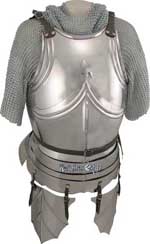Plate Armor
Plate Armor
 Plate armor is personal armor made from large metal plates, worn on the chest and sometimes the entire body (suit of armor).
Plate armor protecting the chest and the lower limbs was used by the ancient Greeks and Romans, but it fell into disuse after the collapse of the Roman Empire. Single plates of metal armor were again used from the late 13th century on, to protect joints and shins, and these were worn over a full chainmail. By the end of the 14th century, larger and complete full plates of armor had been developed. During the early 1500s the helmet and neckguard design was reformed to produce the so-called Nürnberg armor, many of them masterpieces of workmanship and design. European leaders in armoring techniques were northern Italians and southern Germans. This led to the styles of Milanese from Milan, and Gothic from the Holy Roman Empire. Serbia produced armor in Novo Brdo and Kotor and England produced armor in Greenwich and they both developed their own unique style. Maximilian style armor immediately followed this, in the early 16th century. Maximilian armor was typically denoted by fluting and decorative etching, as opposed to the plainer finish on 15th century white armor. This era also saw the use of close helms, as opposed to the 15th century style sallets and barbutes.
Plate armor is personal armor made from large metal plates, worn on the chest and sometimes the entire body (suit of armor).
Plate armor protecting the chest and the lower limbs was used by the ancient Greeks and Romans, but it fell into disuse after the collapse of the Roman Empire. Single plates of metal armor were again used from the late 13th century on, to protect joints and shins, and these were worn over a full chainmail. By the end of the 14th century, larger and complete full plates of armor had been developed. During the early 1500s the helmet and neckguard design was reformed to produce the so-called Nürnberg armor, many of them masterpieces of workmanship and design. European leaders in armoring techniques were northern Italians and southern Germans. This led to the styles of Milanese from Milan, and Gothic from the Holy Roman Empire. Serbia produced armor in Novo Brdo and Kotor and England produced armor in Greenwich and they both developed their own unique style. Maximilian style armor immediately followed this, in the early 16th century. Maximilian armor was typically denoted by fluting and decorative etching, as opposed to the plainer finish on 15th century white armor. This era also saw the use of close helms, as opposed to the 15th century style sallets and barbutes.
Full plate armor was very expensive to produce and remained therefore restricted to the upper strata of society, and lavishly decorated suits of armor remained the fashion with 18th century nobles and generals long after they had ceased to be militarily useful due to the introduction of firearms in the battlefield. Reduced plate armor, typically consisting of a breastplate, a burgonet, morion or cabasset and gauntlets, however, also became popular among 16th century mercenaries and there are many references to so-called munition armor being ordered for infantrymen at a fraction of the cost of full plate armor. From the 15th century on, armor specifically designed for jousting (rather than for battle) and parade armor also became popular. Many of the latter were decorated with biblical or mythological motifs.
Plate armor could have consisted of a helmet, a gorget (or bevor), pauldrons (or spaulders), couters, vambraces, gauntlets, a cuirass (back and breastplate) with a fauld, tassets and a culet, a mail skirt, cuisses, poleyns, greaves, and sabatons. While it looks heavy, a full plate armor set could be as light as only 45 pounds if well made of tempered steel. This is less than the weight of modern combat gear of an infantry soldier, and the weight is better distributed. The weight was so well spread over the body that a fit man could run, or jump into his saddle. Modern re-enactment activity has proven it is even possible to swim in armor. It is possible for a fit and trained man in armor to run after and catch an unarmored archer. Knights in enormously heavy jousting armor were not winched onto their horses. This type of "sporting" armor was meant only for ceremonial lancing matches and its design was deliberately made extremely thick to protect the wearer from severe accidents, such as the one which caused the death of King Henry II of France.



